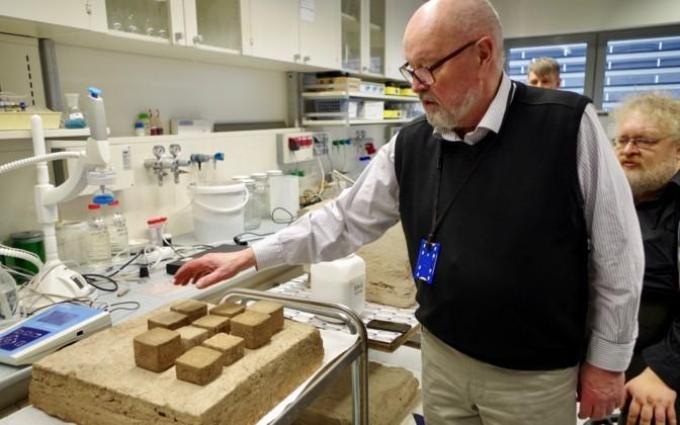Jul 10 2018
Tartu researchers have developed a unique material, which could make rapid and cost-effective 3D-printing of energy-efficient buildings from oil shale ash and milled peat a reality.
 After determining the humic and fulvic acid content in peat and conducting the XRD analysis of elements and minerals, the possible test mixtures were modeled and small test pieces printed. On the photo, Toomas Tenno is showing these test pieces. (Credit: Merilyn Merisalu)
After determining the humic and fulvic acid content in peat and conducting the XRD analysis of elements and minerals, the possible test mixtures were modeled and small test pieces printed. On the photo, Toomas Tenno is showing these test pieces. (Credit: Merilyn Merisalu)
Scientists from the Estonian University of Life Sciences and the University of Tartu have fabricated a construction material that is mainly made up of oil shale ash and peat, which may lower the construction costs of a private house by almost 10 times.
The objective was to create such a self-supporting construction material using locally available natural resources and waste that can possibly be used to 3D print up to two-storey high buildings directly on the construction site.
Better Use of Resources
Although wetlands constitute nearly 22% of Estonia's area, the peat growing there is used very tiny quantities. Until now, only the drier top part of the peat layer is considered usable, and the unused part is allowed to rot.
Moreover, this peat can be used in a more cost-effective manner. Several fractions can be separated from peat, such as waxes and humic substances, and the end residue can even be used to produce cellulose.
Milling is the most widely accepted technique for mining peat. During this process, layers measuring 10-20-mm in size are cut loose from the peat deposit and allowed to dry. In order for this method to be efficient, the majority of milling fields are spread over 100 hectares.
Raising the Value of Waste
“So far, no one has produced peat composite as a construction material because peat prevents many materials from hardening. In our project, we managed to overcome this issue,” said Liiv excitedly.
Scientists from Tartu replaced the usual cement with oil shale ash as the binder in their mix. In Estonia, nearly 7 million tons of oil shale ash are created annually, out of which a mere 5% is reused. The remaining is deposited in ash hills, contributing to significant environmental pollution.
Oil shale ash is categorized as a hazardous waste since it becomes very basic when it comes in contact with water (pH nearly 13). Conversely, ash with such a pH is the most suitable solution for construction materials. The developed material is fully non-toxic and safe for the environment.
Moreover, while testing, researchers discovered a method for decreasing the setting time from roughly 30 days to one day. In case the pH of a pore solution is less than 9, it will not harden even slightly. This problem is overcome by a very high pH by binding the alkali metals and potassium oxide present in oil shale ash to insoluble compounds.
Within the peat, oil shale ash absorbs carbon dioxide by reacting with humic acids. The binder becomes regular limestone and concrete because of chemical reactions.
Toomas Tenno, a professor at the University of Tartu's chair of colloidal and environmental chemistry, informed that nanosized additives, such as silicon smoke or nanosilica, are added to oil shale ash and peat to enhance their properties.
As the particles are very small, they dissolve well and distribute throughout the material evenly. Silicon smoke improves the quality of this material significantly.
Toomas Tenno, Professor, the University of Tartu
Good properties
It took nearly a year to find the right mixture for a strong material with very good thermal conductivity. Following final hardening, the material is very light and strong, is durable, and has low heat transfer. Although peat is also employed as fuel, the material developed by researchers is incombustible.
While the peat material attains its initial hardness in 24 hours, it retains its elasticity for a significantly longer time. Thus, insulation or fillers are not required, and without the adding any wind protection, the whole structure becomes airtight. Moreover, it is a good noise blocker.
Since oil shale ash and peat are not very expensive, house builders would be particularly happy about the material cost. According to Liiv, researchers pegged the cost for the construction of a house shell printed from this material with a floor surface of 100-150 square meters at approximately €5,000 (as opposed to the construction of the shell of a framed building of similar size, which would be nearly 10 times as expensive).
As of now, the research along with several tests has been completed. Issues faced with materials technology have been efficiently resolved. Although peat material is ready for manufacture as elements, more work needs to be done for 3D printing.